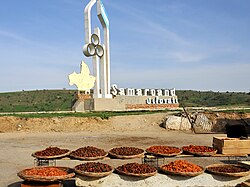Our website is made possible by displaying online advertisements to our visitors.
Please consider supporting us by disabling your ad blocker.
Samarqand Region
A request that this article title be changed to Samarkand Region is under discussion. Please do not move this article until the discussion is closed. |
Samarkand Region
Самарқанд вилояти / Samarqand viloyati Самаркандская область | |
|---|---|
 'Welcome to Samarkand' | |
 Samarkand in Uzbekistan | |
| Coordinates: 39°50′N 66°15′E / 39.833°N 66.250°E | |
| Country | Uzbekistan |
| Established | 1938 |
| Capital | Samarkand |
| Government | |
| • Hokim | Erkinjon Turdimov |
| Area | |
• Total | 16,773 km2 (6,476 sq mi) |
| Elevation | 577 m (1,893 ft) |
| Population (2022) | |
• Total | 4,031,324 |
| • Density | 240/km2 (620/sq mi) |
| Time zone | UTC+5 (East) |
| • Summer (DST) | UTC+5 (not observed) |
| ISO 3166 code | UZ-SA |
| Districts | 14 |
| Cities | 11 |
| Website | www |
Samarkand Region[a][b] is the most populous region of Uzbekistan.[1] It is located in the center of the country in the basin of the Zarafshan River. It borders Tajikistan, Navoiy Region, Jizzakh Region and Qashqadaryo Region. It covers an area of 16,773 km2. The population is estimated to be around 4,031,324, with some 63% living in rural areas (as of 2022).[1]
Samarkand Region was established on 15 January 1938,[2] and is divided into 14 administrative districts and two district-level cities.[3] The capital is Samarkand (pop. ≈551,700 as of 2021).[4][5] Other major towns include Bulungʻur, Juma, Ishtixon, Kattakurgan, Urgut, and Oqtosh.
The climate is a typically arid continental climate.
Samarkand is the second-largest center for economy, science, and culture in Uzbekistan, after Tashkent. The region's UNESCO World Heritage Site architectural monuments make Samarkand the largest center for international tourism in the country. Samarkand Region also has significant natural resources, including construction materials such as marble, granite, limestone, carbonate, and chalk. The region's major agricultural activities are cotton and cereal growing, winemaking and sericulture. Metal processing (spare parts for automobiles and combines), food processing, textiles, and ceramics are the area's most active industries.
The region has a well-developed transport infrastructure, with over 400 km of railways and 4,100 km of surfaced roads. The telecommunication infrastructure is also well developed.
Cite error: There are <ref group=lower-alpha> tags or {{efn}} templates on this page, but the references will not show without a {{reflist|group=lower-alpha}} template or {{notelist}} template (see the help page).
- ^ a b "O'zbekistonda eng ko'p aholi qaysi viloyatda yashaydi?". Qalampir.uz (in Uzbek). Retrieved 2022-02-10.
- ^ Information about the Samarkand Region Archived 2007-10-08 at the Wayback Machine, www.samarqand.uz, accessed on 2007-07-21.
- ^ Cite error: The named reference
statwas invoked but never defined (see the help page). - ^ Cite error: The named reference
classwas invoked but never defined (see the help page). - ^ "Urban and rural population by district" (PDF) (in Uzbek). Samarkand regional department of statistics.
Previous Page Next Page


